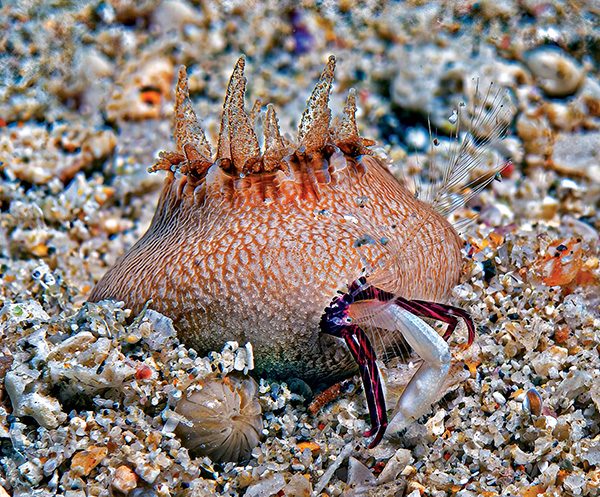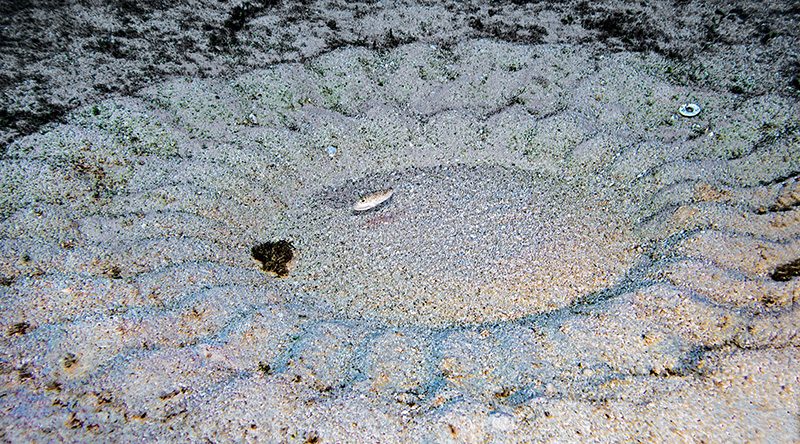MANY JAPANESE DIVERS LOVE UNDERSEA CREATURES, particularly the home-grown varieties living in abundance along the country’s craggy volcanic coastlines and offshore islands. They also have an infatuation for the eccentric — the stranger the better.
News spread quickly across the country following the 1995 discovery of mysterious 6-foot, crop-circle-like sand structures adorning the inshore seabed off Amami Ōshima, one of Japan’s southernmost islands.
The creator of the mystifying circles remained unknown until 2011, when a curious underwater photographer discovered the mastermind behind the fascinating feats. The heroic excavator of the Herculean task was an unknown and unnamed 4-inch pufferfish, every bit as cute as its monumental geometric sculptures are impressive.
Researchers investigated the motive behind the puffers’ extravagant efforts and found that the labyrinthine sandcastles — sculpted by tens of thousands of lineal trenches plowed by tiny thrashing fins — serve as enchanting love nests to beguile mates.
It wasn’t just local interest that was piqued by the delightful findings. In the summer of 2017, an episode of Big Pacific on PBS introduced TV audiences to the intriguing exploits of the subsequently scientifically described puffer, Torquigener albomaculosus. Anna and I were instantly drawn into the captivating four-minute segment depicting one of the seas’ most sophisticated examples of sexual selection — an exceptional behavior where the females have the upper hand in selecting mates.

A single species of hermit crab, Diogenes heteropsammicola, has adapted to live symbiotically with solitary polyps of walking coral inhabiting Amami’s sandy underwater terrain. The hermit crabs use their long pair of antennae to filter organic food particles from the water.
For the longest time it didn’t occur to us that we could and should visit these puffers. Our mindset changed when we received word that we had a connection in Amami: Ume, our capable divemaster from a previous trip to Japan, now owns and operates a small dive center on the island.
We flew with two friends from Tokyo to Amami. Two hours later the wheels touched down on a forested green mountainscape rising from the bluest of seas. Long celebrated for its unique biodiversity, this isolated island — the seventh-largest in Japan — was added to UNESCO’s World Heritage List in 2021.
Ever-smiling Ume and two vans met us and our terrifying pile of luggage at the airport. We were whisked away for an 80-minute excursion along green-draped cliffs through 13 mountain tunnels and around a vast mangrove-lined lagoon dotted with kayakers. We arrived at the opposite end of the island, where the mystery circles were discovered, and made the first of two puffer dives the following morning.
From a shallow mooring we set off behind Ume, who led us over a ridge and down a deep sand slope stretching as far as we could see. This empty world of endless sand and few predators seemed a practical location to build a nest for tasty, fat-filled eggs. But the solitude suggested another matter: How will the males attract mates to the middle of nowhere? An acceptable enticement would have to be faultless in every detail with whatever premium that would tickle a female’s fancy.

A busy male puffer finishes the early construction stage of an intricate 6-foot (1,8 meters) egg nest to impress females.
Over time the puffers sorted out the matter in grand fashion, creating a circular sandcastle engineered with precision and adorned with sea trinkets. Researchers logged plenty of spawning in their first season monitoring the circles. Slightly larger females visit the building projects during construction, causing the hard-working males to work even harder.
The seven- to nine-day project ends when the first gravid female enters the central circle. Positioned side-by-side, the pair releases gametes into an irresistible bed of the finest sand funneled by structurally precise hydrodynamic channeling of currents and the male’s relentless churning. After mating with multiple partners for several days, the father-to-be stands guard until his offspring hatch six days later.
Our visit in early May coincided with the completion of the first stage of construction with all the circles, peaks, and radial grooves in place. During the coming week the male puffer would refine the crude features to perfection and detail it with shards of coral and shell. But there was more to see in Amami.
On the way back to the boat, I spy Anna waving me over to yet another extraordinary natural history narrative. The seemingly vacant seabed is home to two species of walking corals that settle from the pelagic onto small gastropod shells already colonized by tiny, symbiotic peanut worms. As each solitary polyp spreads a protective calcium covering over its vulnerable body, it leaves a tiny opening. The hole allows the detritus-picking worm to feed and pull the thimble-sized corallite about, inchworm style, while keeping the host’s delicate tentacles upright and unburied.
We studied the strange symbiotic relationship years ago in Bali. But we’re in Amami, so there has to be a twist. Sure enough, an endemic filter-feeding hermit crab has evolved — slender body and all — to usurp the worms’ coral-toting duties. AD
© Alert Diver - Q4 2023